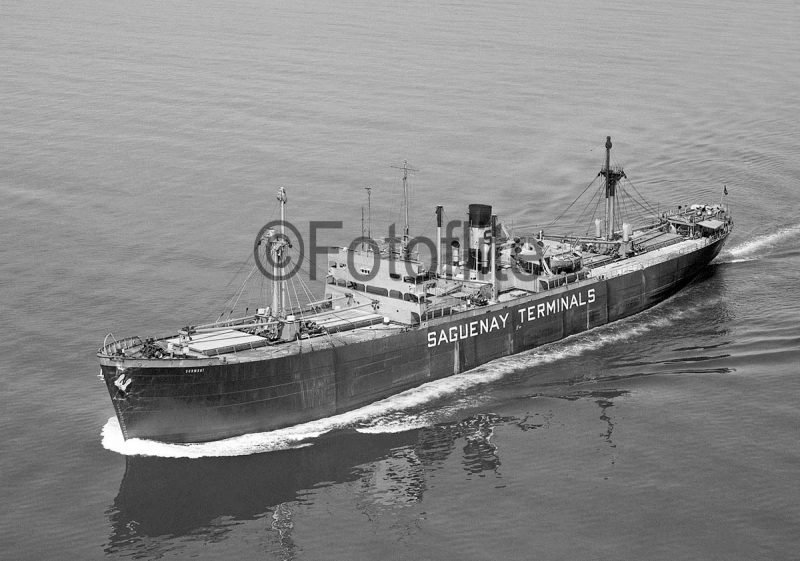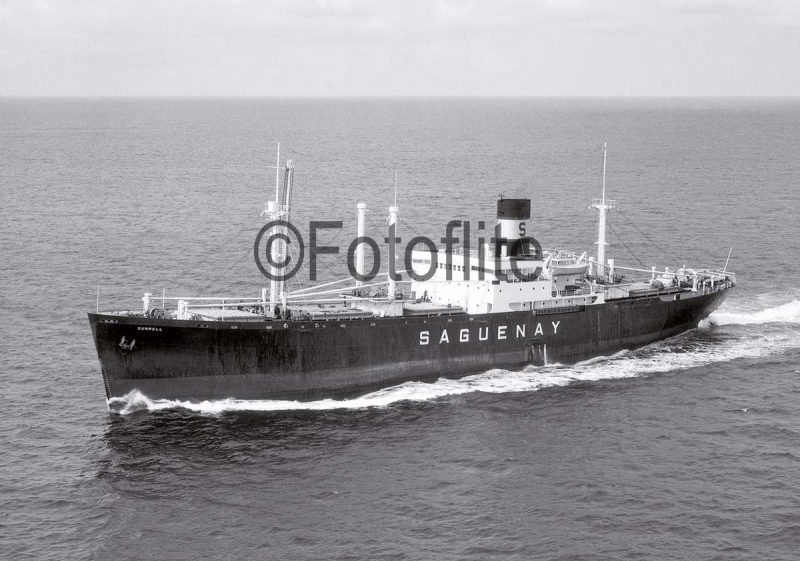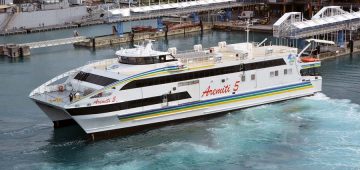A Tale of Two Rivers

![]() The Canadian shipping company of Saguenay Terminals of Montreal operated a big fleet of owned and chartered general cargo ships, ore/oil ships, and geared dry bulkers for over four decades for the aluminium industry of Alcan. They were mainly employed on a route linking two rivers four thousand miles apart, the beautiful Saguenay river flowing as the biggest tributary into the St. Lawrence estuary, and the hot and humid Demerara river in British Guiana, now Guyana. These ships also operated on other routes from the St. Lawrence to Guinea in West Africa, also to Kitimat (BC) from Jamaica, to Alcan plants in Norway and the U.K. The shallow depth of the Demerara river needed smaller ore/oil ships to load shuttle cargoes of bauxite for transport to the Chaguaramas plant near Port of Spain in Trinidad, which converted the bauxite into alumina white powder, and then back load with cargoes of bunker ‘C’ fuel oil from South Trinidad, San Fernando or Caripito on the San Juan river in Venezuela.
The Canadian shipping company of Saguenay Terminals of Montreal operated a big fleet of owned and chartered general cargo ships, ore/oil ships, and geared dry bulkers for over four decades for the aluminium industry of Alcan. They were mainly employed on a route linking two rivers four thousand miles apart, the beautiful Saguenay river flowing as the biggest tributary into the St. Lawrence estuary, and the hot and humid Demerara river in British Guiana, now Guyana. These ships also operated on other routes from the St. Lawrence to Guinea in West Africa, also to Kitimat (BC) from Jamaica, to Alcan plants in Norway and the U.K. The shallow depth of the Demerara river needed smaller ore/oil ships to load shuttle cargoes of bauxite for transport to the Chaguaramas plant near Port of Spain in Trinidad, which converted the bauxite into alumina white powder, and then back load with cargoes of bunker ‘C’ fuel oil from South Trinidad, San Fernando or Caripito on the San Juan river in Venezuela.
The Saguenay River
The Saguenay river flows through a beautiful natural fjord into the St. Lawrence, and was formed from a retreating glacier splitting a deep crack in the Earth’s crust during the last Ice Age, over ten thousand years ago. The inky waters run for 95 miles up to 985 feet deep beneath cliffs that average three hundred feet in height. Running from Lac St. Jean to the St. Lawrence, the Saguenay is known for its lush forests and wildlife that abound in the lower reaches. A Canadian Federal Marine Park occupies the southern half of the river, with whales and dolphins to be seen from riverboats. A beautiful view of most of the length of the sunken fjord is available on the western shore at Cape Trinity, a cliff that rises 1,050 feet over the channel, with a statue of the Virgin Mary overlooking the scenery from the lowest ledge.


However, the sunken Saguenay river underwent a dramatic transformation prior to and after World War II, as the exploitation of the Saguenay for hydro-electric power led to the construction of the largest aluminium plant in the world at Arvida, near Chicoutimi. The industrial town of Arvida was founded in 1927 and named after Arthur Vining Davis, President of the Alcoa company, later Alcan. The first aluminium smelter was constructed here, and the town was developed as a company town for 14,000 inhabitants, with schools, four Catholic parishes, and priests of other denominations, with the town completed in 135 days, and was later in post-war years renamed Jonquiere. Nearby Chicoutimi is known as the ‘Queen of the North’ with its colourful timber houses and majestic scenery. Port Alfred was founded on 22nd April 1918 by a French Canadian industrialist and annexed the village of Grande Baie in 1953, with the Alcan discharging quay at Port Alfred now massively expanded to berth three large bulk carriers simultaneously at the Duncan and Powell Wharves. Chicoutimi has a summer cruising season for Saguenay riverboats during the four months from June to September, and also has a cruise terminal where the biggest cruise liners in the world call in, including the QM2 of Cunard Line. The boroughs of Chicoutimi, Port Alfred, Jonquiere and La Baie are today all part of the city of Saguenay at the head of navigation on the Saguenay river.

The Isle Maligne Power Station came on stream during 1925 as the largest in the world, and two years later the first ingots of aluminium were produced at the Arvida plant. In 1932, Chute-a-Caron Power Station near Kenogami came on stream, and the nearby Shipshaw Power Station came on stream during 1940 to provide the huge amounts of electricity needed to convert bauxite into alumina, and then alumina into aluminium ingots by electrolysis. The smelter expanded during World War II and further large hydro-electric schemes were completed to become the largest aluminium producing plant in the world. Its importance to the Allied cause was show by the large number of anti-aircraft gun batteries surrounding the plant to prevent any Axis attempt to bomb it. The plant employed 7,500 men throughout the 1950s and 1960s, and was due to close in 2005, but was saved by Rio Tinto Alcan as an important commercial aluminium smelter.

Subscribe today to read the full article!
Simply click below to subscribe and not only read the full article instantly, but gain unparalleled access to the specialist magazine for shipping enthusiasts.





Comments
Sorry, comments are closed for this item